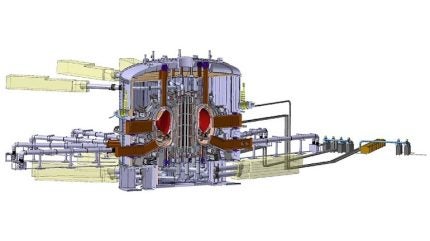
The DV Efremov Institute of Electrophysical Apparatus (NIIEFA Nauchno Issledovatelskii Institut Elektrofizicheskoi Apparaturi), part of Rosatom has been completed the preliminary design of the TRT (tokamak with reactor technologies) reactor.
Rosatom describes the TRT as “a tokamak with a long discharge pulse, a strong magnetic field and an electromagnetic system made of a high-temperature superconductor … the construction of the TRT is an important stage in the development of controlled thermonuclear fusion and the creation of a nuclear power reactor in Russia – an environmentally friendly source of energy with virtually inexhaustible fuel resources”.
The preliminary design provides a general idea of the structure, dimensions and operating principles for the TRT as well as the technical requirements for the external systems of the tokamak such as the power supply, cryogenic cooling, water cooling, vacuum pumping and maintaining operating pressure. The TRT is designed to play a key role in Russia’s plan to develop future nuclear fusion and/or fusion-fission hybrid power reactors.
The project, led by Rosatom’s Department of Scientific & Technical Programmes & Projects, is part of the Comprehensive Programme for the Development of Engineering, Technology & Scientific Research (RTTN – Razvitii Tekhniki Tekhnologii I Nauchnikh Issledovanii) in the field of the use of atomic energy in the Russian Federation to 2024.
Alexey Konstantinov, Deputy Director and Chief Designer of Alexey Konstantinov of Science & Technology Centre Sintez (a division of NIIEFA) said: “The preliminary design of a tokamak with reactor technologies developed at JSC NIIEFA is a major milestone … acceptance of the preliminary design marks the start of further work on the creation of the TRT both at JSC NIIEFA and at other research centres, institutes, and enterprises … the results of the work provide the opportunity to move on to the next stage – the development of the technical design of the TRT.”
Sergey Gertsog, Director General of NIIEFA, said: “The implementation of such a project will provide a virtually unlimited source of clean and safe energy and significantly reduce dependence on fossil fuels, as well as reduce greenhouse gas emissions. Possession of such technologies will raise the country to a new level of technological development and attract investment in research and development, which will contribute to the development of related industries, such as materials science, cryogenic technology and supercomputers, and the creation of new jobs.”
The preliminary design work for the TRT began in 2022 based among other things, on experience and knowledge gained from participation in the international ITER project to build a fusion plant in southern France. “A large number of new technologies that do not exist anywhere else in the world will be tested for the first time at TRT,” Rosatom noted. A concept paper describes the project as being “developed to facilitate fast and economically sound transition to the pure fusion reactor as well as to the fusion neutron source for a hybrid fusion-fission system”.
The Troitsk Institute of Innovative & Thermonuclear Research (TRINITI) is now preparing the necessary infrastructure for TRT construction. TRT will be used to study plasma behaviour in quasi-stationary modes close to ignition and improve methods of additional plasma heating, fuel supply, and blanket technologies. The device will also be helpful in developing new diagnostic techniques and tritium technologies. TRINITI plans to complete the first phase of the thermonuclear facility retrofitting project by the end of 2024. Trinit I aiming to build TRT by 2030 Deputy Director General Kirill Ilyin told Strana Rosatom in 2021. Ilyin said the RTTN programme is a major undertaking and more than half of the institute will be involved in reconstruction activities in preparation, which began in 2020. TRINITI (formerly a branch of the Kurchatov Institute) has not seen such capital construction since the1980s.
Ilyin said TRT will be built at TRINITI site where the TSP strong-field tokamak is now located. The TSP tokamak began operation in 1987 but was suspended due to lack of funds following the collapse of the USSR. It has four satellite buildings with auxiliary infrastructure. Major reconstruction is planned as part of the RTTN programme. “Four shock generators, cryogenic and vacuum systems, and a cooling system will be modernised, and a test facility has been created that will confirm the capabilities of the infrastructure and test individual elements of tokamaks,” he noted.
New installations for thermonuclear and plasma research are also being developed elsewhere in Russia. For instance, the T-15MD tokamak at the Kurchatov Institute will soon start operating at full capacity. All the facilities developed under the RTTN programme will have a common infrastructure. One of the subsections of the plasma-thermonuclear section is devoted to hybrid systems – fusion-fission reactors, which can be used not only to generate electricity, but also to generate fuel and burn minor actinides. Another area of research and development is the modification of materials using plasma and laser technologies.






